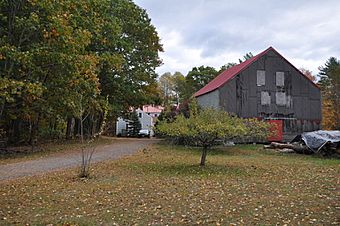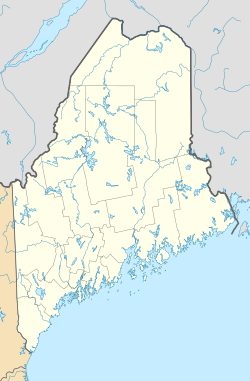Purinton Family Farm facts for kids
Quick facts for kids |
|
|
Purinton Family Farm
|
|
 |
|
| Location | 65 Elm St., Topsham, Maine |
|---|---|
| Area | 12 acres (4.9 ha) |
| Built | 1810 |
| Architectural style | Federal |
| NRHP reference No. | 89000842 |
| Added to NRHP | July 13, 1989 |
The Purinton Family Farm is a very old farm at 65 Elm Street in Topsham, Maine. It has three main buildings that were built a long time ago, between the late 1700s and early 1800s. This farm is special because it's one of the few places left in Maine that shows how farms looked in the early 1800s.
Scientists have also found old things on the farm. They found signs of an even older house and tools from people who lived there thousands of years ago. Because it's so important, the farm was added to the National Register of Historic Places in 1989. This list helps protect important historical places in the United States.
Contents
What Makes the Purinton Family Farm Special?
The Purinton Family Farm is located near the Androscoggin River. It's also close to a road called the Brunswick-Topsham Bypass and Elm Street. On its eastern side, there's a small valley that separates it from the Topsham Public Library.
The Farm Buildings
The farm has three main wooden buildings:
- The main house
- A barn
- A special building for storing grain, called a crib
The main house is a two-and-a-half story building with a sloped roof. It has a long kitchen area that sticks out from the side. The barn is located to the west of the house, and the grain crib is nearby. The grain crib is interesting because it's made from very strong, heavy wood. This suggests that the wood might have been used in another building before being used for the crib.
Who Lived at the Farm?
People have lived on or used this land for a very long time!
Ancient History
Scientists have studied one part of the farm and found proof that people lived there between 4,000 and 3,000 years ago. These were prehistoric people, meaning they lived before written history.
Early European Settlers
The first European settlers came to this land in the 1760s. A man named Robert Gore built a type of strong, fortified house there. This house was likely taken down in the early 1800s. Scientists found what they think might be the foundation of this old house during their research.
In 1775, Robert Gore sold the land to James Purinton. James and his son Ezekiel built the house, barn, and grain crib that you can still see today. The Purinton family owned and lived on the farm until 1936, which is a very long time!



